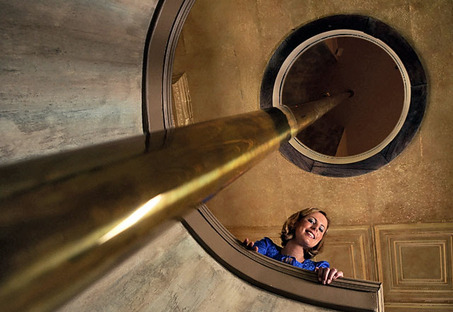IN THE NEWS
Development company restores a bit of an old Syracuse fire station
Michelle Gabel/The Post-Standard
Erica Bernhardt Pigula, an interior design consultant with JGB Properties LLC,
peers over a railing near a fire pole in the former fire station at 238 W.
Division St. The company renovated the building as a new home for its offices.
Step into JGB Properties LLC's new offices in Syracuse, and you'll see something no other office in the city has: a fire pole. The kind firefighters slide down.
JGB, a real estate development company, installed the brass pole in the summer while turning the former city fire station at 238 W. Division St. into its offices.
"We wanted to retain some of the original aspects of the fire station," said Jay Bernhardt, founder and president of the company.
Built in 1915, the Engine 14 fire station at Solar and West Division streets has not been used by firefighters for a long time. The city stopped using the building as a fire station in 1961.
For 10 years, the city used it for storage. In 1971, the city sold it to
two businessmen, Wolfgang Wagner and Howard Edminster, for $22,000. They
used it as offices for their Faul Coradi equipment and supply company.
Faul Coradi later sold it to J.W. Stevenson Co., an air-conditioning company.
David Crandall, founder and president of Environmental Design & Research, acquired the building in 1996 and used it for his company offices. JGB bought the building from Crandall for $440,000 in January 2008.
Erica Bernhardt Pigula, Jay Bernhardt's daughter and an interior design consultant for JGB, said her father liked the building because of its location near the Syracuse Inner Harbor and because he just plain likes restoring old buildings.
Another motivation was his connection to fire departments, she said. A JGB affiliate, Key Fire Hose Corp., of Miami, makes fire hoses, and Bernhardt's JGB Enterprises Inc., in Liverpool, makes hose assemblies for commercial and military applications.
The building retains its original tin ceiling panels, brick interior walls and six large wood lockers where firefighters stored their gear.
It also still has a tower where firefighters hung their cotton-jacketed fire hoses to dry. JGB has hung six hoses in the tower for old time's sake.
But the original two fire poles that provided a way for firefighters to quickly get from the second floor to the fire engines on the first floor are long gone, and the holes in the ceiling were covered with wood.
So JGB bought a brass pole from McIntire Brass Works Inc., a Somerville, Mass., company that still makes fire poles, also known as slide poles. It uncovered one of the original holes in the first-floor ceiling and installed the pole, complete with a neoprene landing mat at the bottom.
"We all knew from Day 1 we had to get a fire pole in here," said Christine Stevens, project manager for JGB.
While the pole's main purpose is a visual reminder of the building's former use, it's also fully functional. Stevens said employees and visitors are welcome to slide down it, but only after signing a liability waiver.
Only one person has made the trip down the pole -- David Sinclair, a retired Syracuse fire lieutenant who helped Stevens research the building's history.
Sinclair did not sign the waiver, though. When Stevens told him he had to sign it, he laughed, jumped on the pole and slid right down.
"It would be funny for a retired firefighter to sign something before sliding down a fire pole," said Sinclair, 70.
(315)2344184 | info@jgbproperties.com
Copyright © 2000 - 2017 JGB Properties, LLC. All rights reserved.


